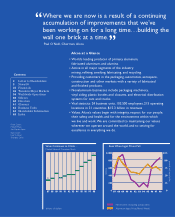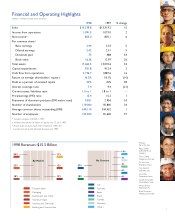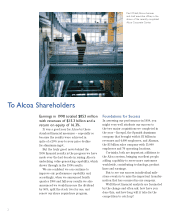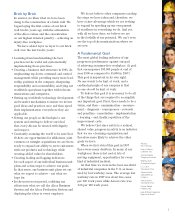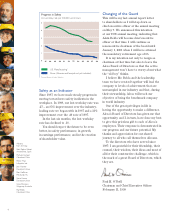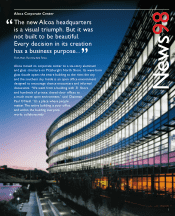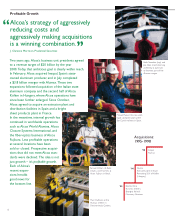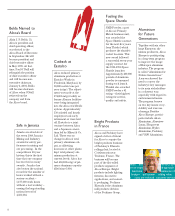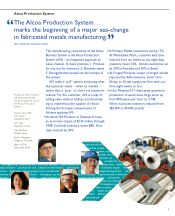Alcoa 1998 Annual Report Download - page 5
Download and view the complete annual report
Please find page 5 of the 1998 Alcoa annual report below. You can navigate through the pages in the report by either clicking on the pages listed below, or by using the keyword search tool below to find specific information within the annual report.
3
Alcoans,
from the top:
Kevin Hubertz
Lafayette, Ind.
Quintin Bowles
Wagerup, Australia
Begoña Zufin
Amorebieta, Spain
L.C. Clark
Cleveland, Ohio
Szántó Laszló
Székesfehérvár,
Hungary
Velma Brown
Cleveland, Ohio
Mauro Zoboli
Modena, Italy
José Antônio Cavalcante
Itapissuma, Brazil
Brick by Brick
In answer, we liken what we have been
doing to the construction of a brick wall. We
began laying the first course of our brick
wall twelve years ago with the articulation
of the Alcoa values and the concentration
on our highest internal priority – achieving an
injury-free workplace.
We have added layer on layer to our brick
wall over the last twelve years:
• Learning from benchmarking the best
practices in the world and systematically
implementing those practices.
• Creating a business unit structure in 1991, de-
emphasizing top-down, command and control
management while providing many more lead-
ership positions in the company, sharpening
responsibility and accountability, and tying our
worldwide operations together with telecom-
munications and computers.
• Setting up worldwide technology development
and transfer mechanisms to insure we invent
good ideas and practices once and then speed
their implementation everywhere they are
applicable.
• Setting out people as the linchpin to our
system and striving to deliver our ideal
that every Alcoan be treated with dignity
and respect.
• Constantly scanning the world to be sure that
if there are opportunities for affiliations, joint
ventures or outright acquisitions we are there,
ready to expand our ability to serve customers
with our products and technology while
creating added value for shareholders.
• Creating leading and lagging indicators
for each aspect of our individual business unit
plans and action steps to achieve our goals.
In that sense, our business unit plans set out
what we expect to achieve – not what we
hope for.
• In the most recent period, codifying our
efforts into what we call the Alcoa Business
System and the Alcoa Production System and
deploying the ideas to every employee.
We do not believe other companies can skip
the steps we have taken and, therefore, we
have a time advantage which we are seeking
to expand by speeding up our own pursuit
of excellence in everything we do. And yet,
with all we have done, we believe we are
in the foothills of our potential. We can’t even
see the top of the mountain from where we
are now.
A Fundamental Goal
The most global leading indicator of our
progress is performance against our goal
of achieving an injury-free workplace. (A goal
that encompasses 103,500 people at end of
year 1998 as compared to 55,000 in 1987.)
This goal is important in its own right.
No one wants to be hurt at work, and a
cardinal principle of our company is that
no one should be hurt at work.
To deliver this goal it is necessary to do all
of the things that are required to accomplish
any important goal. First, there needs to be a
vision, and then – communication – measure-
ment – diagnosis – consequences – rewards
and penalties – remediation – implementation
– learning – and, finally, repetition of the
improvement cycle.
We believe that since safety is a natural,
shared value, progress in safety is an indicator
that we are a learning organization and
therefore more likely to achieve the other
goals we have.
When we first stated this goal in 1987
there were many doubters. In many of our
workplaces there is hot metal, lots of
moving equipment, opportunities for every
kind of industrial incident.
At that time we were in the best one-third
of industrial companies in the U.S. as meas-
ured by lost workday cases. The average lost
workday rate in 1987 was about five cases
per 100 work years while Alcoa’s rate was
1.86 per 100 work years.


